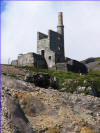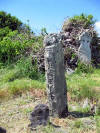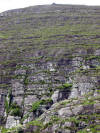|
Beara Historical
Society outing to Allihies
For the first outing of 2008, the members of Beara
Historical Society went to the Allihies area on Sunday 27th April
2008. The first stop was in Reentrusk where members Theo Dalke and his wife
Barbara recently found a Bronze Age copper mine, similar to the mines on Mount
Gabriel, while out walking in the rugged landscape near Cod Head. Theo explained
how the ancient miners found traces of copper ore in a quartz vein at the base
of a large rock outcrop. They collected wood and lit a fire against the face of
the rock and when it was very hot they threw cold water on it. This caused a
thin layer of the surface to shatter. They broke the surface with rounded stone
hammers or mauls and removed the copper ore and dumped the waste material. They
smelted the ore, mixed it with tin and poured it into moulds to make bronze axes
and other artefacts. Over time the waste material formed a large mound in front
of the mine. Broken stone hammers, bits of charcoal and black soil can be seen
on the exposed parts of the mound. Theo suggests that the stone hammers came
from the stony strand in the seashore in Eshavaud to the west. This was the
first time most of the people present were in this remote area. They were
enthralled by the rugged unspoilt scenery and believed that similar prehistoric
mines are awaiting discovery in the general Allihies area.
 The North Engine, Allihies
The North Engine, Allihies
The next stop was at the roadside above the cliffs of
Dooneen where ‘Copper’ John Puxley began copper mining in 1812. In the following
years copper mines were opened in several other locations around the village of
Allihies. In the early years the copper ore was exported in copper schooners
from Ballydonegan and sold to the smelters in Swansea. Later the copper ore was
carted to the sheltered harbour at Dunboy for export. On the return voyage the
schooners brought coal for the steam engines which pumped water out of the mines
as well as hauling the blasted ore bearing rock to the surface for processing.
As the mining expanded the number of men, women and children employed grew from
300 to a peak of 1,200. During the Great Famine in the 1840s, Puxley bought
potatoes in Devon, transported them in the returning schooners and sold them at
cost to his workers. By 1880 the amount of copper ore was declining and the
mines closed down in 1884. This was followed by large scale emigration to
Michigan and later to the newly opened copper mines in Butte, Montana.
There was a brief stop at the burial place of the legendary
Children of Lir on the roadside near Allihies. White quartz stones mark the
graves.
The final stop was at the recently opened Allihies Copper
Mining Museum. This building was originally a Methodist Church built for Cornish
copper miners who were brought over to help open the mines. About ten years ago
The Allihies Mining Museum Committee was set up to restore the then roofless
building. Theo Dalke was one of those deeply involved in the development. With
the help of working models and artefacts collected from the mines, he explained
the various mining processes underground and over ground in the 1800s.
All those present agreed that this was one of the best laid
out and easiest to follow museums they had been to visit and complemented the
Museum Committee on their years of hard work. Then after a cup of tea or coffee
and sandwiches and cakes in the Museum café, the members headed home after an
informative and enjoyable outing. The museum is now open to the public.
Beara Historical Society Outing to Adrigole
Local historian Sean Nicholson was the guide for a large
gathering of members who visited Adrigole on Sunday 29 June 2008. The first stop
was at Kilcaskan where St Cascan set up the first Christian church in Adrigole.
An old graveyard surrounds the ivy-covered ruins of the church. Beside the
church is an ogham stone. After being exposed to the elements for almost two
thousand years, the inscriptions along on side of the stone are now very faint.
Across the road is a large boulder with a bullaun-type hollow on its upper
surface. It is known locally as a holy well and has been visited by generations
of local people. It is the custom to inscribe a cross with a stone or a coin on
the rock surface beside the well and on the bottom of the well. Sean pointed out
a series of rocks leading to the nearby river to the south and said this was a
processional way used by druids in pre-Christian times as part of the rituals at
the bullaun stone.
 Ogham Stone, Kilcaskan Church
Ogham Stone, Kilcaskan Church
The next stop was at Canshanavoe, where Sean and local
farmer Donie O’SuIlivan pointed out a ‘Comhla’ or fairy door leading to the
‘other world’. It is reddish in colour and is at the foot of a steep cliff.
Donie then led the group up the hillside to a Bronze Age copper mine, which has
been dated to 1600BC. He noticed the shallow drivings under a large rock years
ago, but was not sure what they were for. (A local Pisoeg told to children at
bedtime long ago was of a witch that lived behind the red door and who would
sprit naughty children away to the underworld)
 The red Door, Canshanavoe
The red Door, Canshanavoe
The ancient miners in Adrigole found traces of copper ore
in the base of a large rock outcrop. They collected wood and lit a fire against
the face of the rock and when it was very hot they threw cold water on it. This
caused a thin layer of the surface to shatter. They broke the surface with
rounded stone hammers or mauls and removed the copper ore and dumped the waste
material. They smelted the ore, mixed it with tin and poured it into moulds to
make bronze axes and other artefacts. Over time the waste material formed a very
large mound in front of the mine. Broken stone hammers, bits of charcoal and
black soil can be seen on the exposed parts of the mound. Donie suggested the
rounded stone hammers were brought up from the seashore near Adrigole Harbour.
Chairman of the Historical Society, Connie Murphy thanked Sean and Donie for a
most interesting and informative afternoon.
The
next outing of Beara Historical Society is to the Kilcatherine, North o' Hill
and Ardgroom areas on Sunday next 25th May. Meet up at the Square,
Castletownbere to leave at 2 pm. Travelling through Eyeries, Ballycrovane,
Kilcatherine etc. Members from Eyeries area can join in at Eyeries Village or
Ballycrovane.
National Heritage Week 24th
- 31st August
A Town Walk
A very good
number of people met at the Square, Castletownbere at 2 pm on Sunday 24th
August and moved east of the town to near St. Joseph’s Hospital which was
the site where the Castletownbere Coast Guard Station once stood.
 Coastguard Station
Coastguard Station
Here the guide
for the day, Gerdie Harrington, told the group of an attack made on the station
by the local Unit of the IRA in 1920. He told how two of the IRA men wearing
British Army uniforms came to the gate where they handed over a large envelope
to the guard and as he took it they overpowered him and the rest of the
attacking force rushed the main part of the building. But from then on things
went wrong for them, because of gunfire all the Coastguards in the station were
alerted and the British Army stationed at Furious Pier three miles east of the
town were alerted.
Three of the
attacking party were wounded the worst was Johnny McCarthy who had a bullet
close to his heart. He was carried across the road to the nuns’ quarters of the
Workhouse where one of the nuns placed a nuns cloak on him and placed him in a
nun’s bed with a hood over his face and a prayer book in his hand. When the
British arrived to search for him they mistook him for a nun and left. Johnny
carried that bullet throughout his life and later went to the US and on
returning fought with O’Duffy’s Irish Brigade in the Spanish Civil War.
 Castletown Berehaven Union Workhouse Castletown Berehaven Union Workhouse
The next stop
made by the group was the site of the Old Workhouse which they were told was at
one time the town’s main centre as it was here the Castletown Rural District
Council and the Castletown Board of Guardians, met for their fortnightly
meetings in what was known as the Town Hall. They were told the history of the
Workhouse and how it opened just after the Great Famine of 1847. It also had a
hospital, school and farm, and was used by the Free State Army following the
Truce. The only remaining part of the workhouse is the seven foot high wall
surrounding the property which now contains St. Martin’s and St. Joseph’s
Villas.
The group
stopped at the Creamery and were told how it began in 1936 and at one time
employed some twenty people, winning several awards for its butter.
 Brandy Hall School Brandy Hall School
Moving on then
to the Old Brandy Hall National School, where they learned of some of its famous
pupils such as Tim and Ned Harrington, MPs, Judge Adams, and many others. How it
got the Brandy Hall name from the nearby building on the sea front which was the
old presbytery and before that was where smugglers brought in brandy and other
goods.
The group’s
next stop was at the wreck of an old sailing vessel named “Trafalgar” which lay
in the foreshore just across the road from the site of the Bridewell which was a
kind of a holding for prisoners found guilty in the local court pending going to
Cork Jail. The building was demolished some years ago and a block of apartments
built on the site. The group were told the story of the “Trafalgar” how she was
at one time known as a “Coffin Ship” because of her voyages to the US during the
Famine years.
 Murphy's Store Murphy's Store
The group next
moved to the town and starting at Murphy’s Corner to the Beara Bay they learned
what the town was like some fifty or so years ago with its bustling main street,
once full of family owned shops and stores. The town lost over fifty family
businesses in those years. They learned of the number of shoemakers, tailors,
dressmakers, harness makers and public houses which have disappeared, the number
of bakeries, shoe shops, fish curing stations.
 Berehaven Hotel & St Peter's Church
Berehaven Hotel & St Peter's Church
At St. Peter’s Church of Ireland
they learned that it was built in 1845 and had a large congregation in the area.
It has been closed for several years.
 Beara Bay Hotel Beara Bay Hotel
The final stop
was at the Beara Bay Hotel, which was built as a Coast Guard Station and of its
history as the Berehaven Hotel. The building is to be demolished in the near
future and a shopping precinct and apartments built on the site. The face of
Castletownbere is fast changing.
Chairman Connie Murphy thanked Gerdie for acting as guide and for his
massive information and he thanked the people for joining the Historic Society
outing that day.
Cloontreem Valley
On Thursday evening 28th
August a large group of Beara Historical Society members, under the guidance
of the Society’s chairman Connie Murphy, travelled into Cloontreem valley, 3km
north-east of Castletownbere.
Long stretches of stone walls protrude
intermittently above the surface of the remaining bog all along the sloping
eastern side of the valley. In the course of turf cutting over many years,
several sections of pre-bog stone walls have been exposed here. These were the
fields of the prehistoric farmers of this valley. Several circular hut sites
where they lived and fulachtaí fia where they boiled water and cooked meat are
found throughout this eastern side of the valley.
At the head of the valley stands an
impressive Early Bronze Age wedge tomb (c. 4,000 years old), with a commanding
view over Castletownbere and Berehaven Harbour. Just below the wedge tomb are
the well preserved lower stone courses of a large circular house as well as the
remains of two smaller huts, probably the dwelling places of the ancient
chieftains of Cloontreem.
Princess Beara
In the early centuries AD, Conn Céad
Cathach (Con of the hundred battles) fought a fierce battle against Owen Mór,
King of Ireland at Cloch Barraige. Owen was badly injured in the battle. Those
of his followers who survived took him to Inis Greaghraighe (now known as Bere
Island) as a safe place for him to recover. There, the fairy Eadaoin took him to
her grianán (bower) where she nursed him back to full health. Nowadays, this
place is known as Greenane.
Owen and his followers then sailed
southwards until they reached Spain. There he met and married Beara, daughter of
the King of Castille.
Later Owen, Beara and a large army
sailed from Spain and landed in Greenane. Owen took his wife to the highest hill
on the island and looking across the harbour he named the island and the whole
peninsula Beara in honour of his wife. Rossmacowen, Kilmacowen and Buaile Owen
most likely are named after Owen Mór and his son. According to local tradition
Owen’s wife, Princess Beara, died and was buried in Ballard Commons in the
remote and peaceful valley between Maulin and Knocknagree Mountains.
 John O'Sullivan Green and Connie Murphy
John O'Sullivan Green and Connie Murphy
John and Peter O’Sullivan Green, Filane,
who were shown the site by their late father, Michael, pointed out the location
of the burial some time ago. As part of Heritage Week events, and with the help
of John Green, his nephew Finbarr, and their friend Joe Kelly, the memorial
plaque provided by Beara Historical Society was fixed to the large rock-face
beside the burial place of Princess Beara and was unveiled on Sunday 31st
August.
 Members of the Society
Members of the Society
Connie Murphy, chairman of the Society
welcomed the large gathering and outlined the story of Princess Beara. John
Green then unveiled the memorial plaque and spoke of the respect his family had
for this burial going back over several generations. His son David then recited
a poem passed on to him by his Grand-aunt Annie. Ashley Whoulihan and Fachtna
O’Donovan played traditional music and Norelene O’Dwyer sang Maidin i mBéara.
Finally, all joined in singing Amhrán na bFiann.
 Ashley Whoulihan and Norelene O'Dwyer
Ashley Whoulihan and Norelene O'Dwyer
 Fachtna O'Donovan and Ashley Whoulihan
Fachtna O'Donovan and Ashley Whoulihan
Poem passed down in
the O’Sullivan Green family
Queen Bealach Bodhrai was
buried near Knorknagree
All her jewels were
buried there
She married a chief that
died with grief
In the Parish of
Kilmackowen
Beara
Historical Society Outing.
|